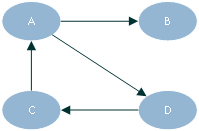Overview
A graph is pretty much a diagram with circles or boxes (called nodes) and lines or arrows (called edges) that connect them. Practically all software architecture diagrams are just graphs of some sort.

The nodes represent "nouns" and the edges represent "verbs" or "relationships".
A directed graph (or digraph) is a graph where each edge has one arrow head. An edge with two arrow heads is considered the same as just a edge with no arrow heads. So for convenience, we never draw edges with two arrowheads. The graph below is a cyclic digraph because there is a cycle in the graph. That is, you can start on A, go to D, then to C, and back to A. You can traverse the graph by starting on A, and then back on A later.

An acyclic digraph (or directed acyclic graph or DAG or short) is a digraph with no cycles. Examples of DAGs are:
- Git commits. Example1, Example2
- A family tree, which is not really a tree but a hybrid graph instead. A person node cannot be its own ancestor, but can have multiple parents and multiple children. And a person can have children with another person; e.g. marriage.
When creating a digraph, a DAGs will always result if each time you add a new node to the graph, you create arrows pointing from it to other existing nodes. The only way to get a cycle is to add an arrow to an existing node that points to another existing node. Cycles are not possible with block chain databases like Git.
A tree is a digraph with the restriction that a node can not have more than one arrow pointing away from it.
